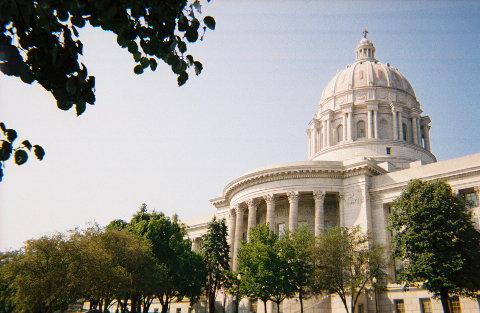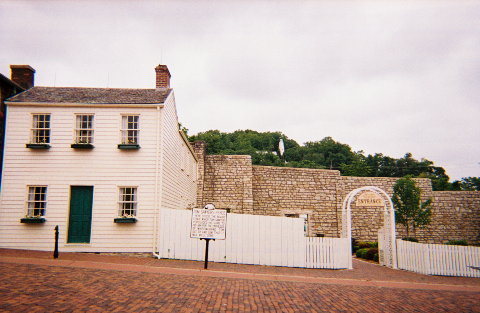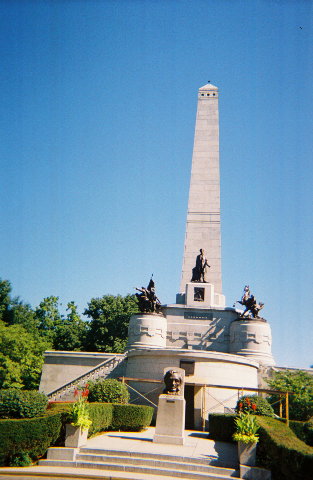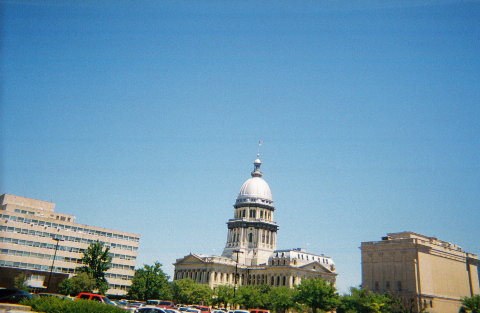
It's been a long time since I've written a travelogue about a domestic trip since most of my U.S. travel consists of either business trips or weekend getaways. However, I took advantage of the National Storytelling Conference in Saint Louis to spend some time exploring parts of Missouri and Illinois that I hadn't been to before and satisfying a couple of obsessions along the way. I decided that was significant enough to be worth writing about.
I started my trip with a weekend in Saint Louis. It was easy to get downtown from the airport using the Metrorail light rail system. My room at the Hilton at the Ballpark had an excellent view of the Gateway Arch, which is the the most famous thing in the city. The view was nice, but I'd have gladly given it up in exchange for better soundproofing.
One of my obsessions is Volksmarching and there was a year-round event to provide a good walking tour of downtown Saint Louis. There's a fair amount of grand architecture, particularly along Market Street, but the city doesn't really have a vibrant downtown. Perhaps it was too early on a weekend morning, but there just weren't very many people around. Laclede's Landing, which is the oldest part of the city and is now an entertainment district, probably does get livelier at night. By day, however, the only place with any significant number of people around was the Gateway Arch. In fact, there were too many people and I passed on the long line to go up to the top.

I did go to the Eugene Field House, however. For those who don't recognize the name, he was known as "children's poet" and you may remember either "Wynken, Blynken and Nod" or "The Gingham Dog and the Calico Cat." His father was the lawyer who defended Dred Scott and the first floor of the house had an exhibit on the case. Overall, though, the museum was disappointing as the third floor, which has most of the toy collection, was closed.
In the evening, I satisfied another obsession by going to a game at Busch Stadium. The ballpark has enthusiastic fans, cushy seats and a nice view of the Arch. The view, however, meant that the seats in my section were angled the wrong way, so I had to turn my head to see the infield. I suspect the Cardinals fans may not have minded not seeing that evening, as shortstop Aaron Miles committed three errors and the Giants won.
In the morning, I returned to the airport and picked up a rental car. My first stop was in Forest Park, where I went to the zoo. It was a very hot day, which limited the animal activity. Even the ring-tailed lemurs (my favorite primates) and the spider monkeys were lethargic in the heat. Similarly, the big cats and most of the bears were dozing in the shade. There is, however, a penguin area, which is cool - literally. The extreme air conditioning is a big draw in the summer and getting to see four kinds of penguins (Humboldt, gentoo, rockhopper, and king) and two kinds of puffins, is a bonus.
After leaving the zoo, I drove westward. I stopped briefly in Saint Charles, where the historic district seemed to be typical Western fare. Then it was off to Jefferson City, to satisfy my obsession with state capitals. A Volksmarch there was a good way to see the city, including the Capitol building, which is grand and classical.

The river side of the Capitol complex has a nice view over the Missouri, as well as various monuments. The rest of the city is less interesting. The central business district seems economically depressed, with a lot of vacant buildings. The walk also included the Jefferson City National Cemetery and the campus of Lincoln University. And a lot of steep hills. The combination of hills, heat and humidity had me thinking of a song we used to chant in my childhood that went "Misery, Missouri misery." Still, I did get a good workout and a sense of accomplishment at the end of the 10 kilometers.
I drove north and east on various backroads to the town of Florida, which is the birthplace of Mark Twain. He described his birthplace as "nearly invisible" in his autobiography and, admittedly, there isn't a lot to the town. There is, however, pleasant scenery along Mark Twain Lake and the Mark Twain Birthplace State Historic Site. The museum at the latter charges $2.50 admission and is well worth it. Aside from the actual cabin Samuel Clemens was born in, there are exhibits ranging from a handwritten manuscript of Tom Sawyer to furniture from his house in Hartford, Connecticut. There's also a very informative video about his life.
It took about an hour to get from Florida to Hannibal, where I spent the night. In the morning, I drove to the downtown area. I obviously hadn't learned my lesson from the previous day as my first activity was to climb up to the top of Cardiff Hill. The foot of the hill has a statue of Tom Sawyer and Huck Finn, while the top has a lighthouse and a view over the whole town. Less energetic tourists could, however, skip the climb without missing a lot.
The essential Hannibal tourism is centered around Mark Twain's boyhood home. An $8 ticket includes several properties - an interpretive center, Huck Finn's house, the actual boyhood home, Becky Thatcher's house, Judge Clemens' office, Dr. Grant's house, and the Mark Twain Museum. The main message out of all of these is that a lot of the stories used in his novels came out of Twain's childhood experiences. A good example was the description (in Dr. Grant's house) of an incident in which the cat licked up medicine that young Sam Clemens had spilled between the floorboards, got agitated and knocked over all the flowerpots - a story which shows up in Tom Sawyer. Speaking of that book, you can also see the famous fence he talked his friends into whitewashing.

There are other properties in town that capitalize on the most famous resident. For example, The Haunted House on Hill Street charges $8 for you to see a wax tableau of Twain characters and real life Clemens family members. After hearing about the wax figures, you walk through an extremely tacky and unscary series of hallways in which your footsteps cause things to jump out at you or light up. There are riverboat rides and tour trains and so on. The only one of these other attractions I found time for was the Mark Twain Cave, which is a ways south of town. The cave tour cost $15. It was pretty typical of the genre, including a lot of corny jokes. For example, there's a structure called "the piano" but it plays only "hard rock." And marriages that start with weddings in the cave get off to a rocky start. Being in Missouri, there is the obligatory claim that Jesse James used the tour as a hideout, with a bit of graffiti alleged to be his signature. The guide also pointed out C. E. Tucker's signature, which appears over 250 times, "giving new meaning to the term 'tuckered out.'"
By the way, Hannibal had another famous one-time resident. The unsinkable Molly Brown is more closely associated with Leadville and Denver, Colorado, but she grew up in Hannibal. Her house is a muuseum with a lot of photos and a few items she owned. The major thing that I learned is that Margaret Tobin Brown was never actually known as Molly in her lifetime.
Another state capital is within easy driving distance, namely Springfield, Illinois. Again, a Volksmarch was a good way to take a thorough walking tour of the city. It was much cooler weather and Springfield is reasonably level, so this was a far more pleasant walk than the Jefferson City one had been. The first part of the walk was to Oak Ridge Cemetery, which is most notable for Lincoln's tomb.

I can never resist a quirky museum, so decided to stop in at the Museum of Funeral Customs ($4 admission) just outside the cemetery. It's reasonably interesting and worth an hour or so, despite being limited to American funeral customs. There are exhibits on topics including embalming fluids, mourning clothes, African-American funerals, military funerals, Lincoln's death train and several others.
Returning to downtown, one passes the Capitol building, which has a reasonably grand dome and a small statue of Stephen Douglas behind the large one of Abe Lincoln.

Lincoln is as much an industry in Springfield as Twain is in Hannibal and you can see his house, the church he worshipped in, the train station he left for Washington from, the building that housed his law office, and so on. The National Park Service tour of the house (free, but you need to get a timed ticket) was reasonably informative. One tends to think of Lincoln as poor, but his law practice was clearly thriving by his time in Springfield, as he could afford pricy toys like a stereograph.
I'm not a real Lincoln devotee, so the taste of Springfield was enough for me. But someone with more interest in Honest Abe could easily fill a second day there, particularly as the Lincoln Museum (which I skipped) is said to be worth a few hours in and of itself. Instead, I drove eastwards to a small town called Arcola, which is in the heart of central Illinois Amish country.
My objective had nothing to do with the Amish, however. Arcola has two unique tourist attractions. One is the hippie memorial, which proved to be a rather unattractive metal sculpture with an interesting story behind it. The artist used dull colored metal, arranged 3 feet tall, to represent the conformity of the 1950's. Bright colored metal, 6 feet tall, represents the hippies breaking through the ceiling of conformity. Alas, a return to the dull shorter metal represents the Reagan era.
The main attraction I'd come to see was the Raggedy Ann Museum. A $1 donation gets you a semi-guided tour (i.e. you are accompanied by the museum's black cat, Halloween) through exhibits about the history of Raggedy Ann and Andy and their creator, Johnny Gruelle, who created Ann for his daughter, Marcella. She died at age 13, but he saw the potential in marketing the doll and the exhibits show many of the products he licensed. There are also lots of dolls, including a big section on Japanese Raggedy Anns (and other Japanese dolls).
My final stop was at Rockome Gardens, about 5 miles from Arcola. This is a sort of Amish theme park, with the odd touch of gardens surrounded by rock arrangements, but I went specifically to see a quilt show. There were some beautiful pieces, with my tastes running towards the more modern designs. One thing I hadn't quite realized is that people can piece the quilt top and then send it out to be machine quilted. It was worth an hour or so before returning to Saint Louis, returning the car and heading to my conference.
Overall, while this may not have been as exciting as some of my trips, it was still worthwhile. I've often found that the best U.S. tourism is in the smaller cities and that was fairly true this time around. Hannibal was the definite highlight. But there was enough to keep me occupied for far longer in the general vicinity. If I had a reason to go to Saint Louis again, I'd certainly consider adding a day or two to see some more of the region.
last updated 10 October 2007